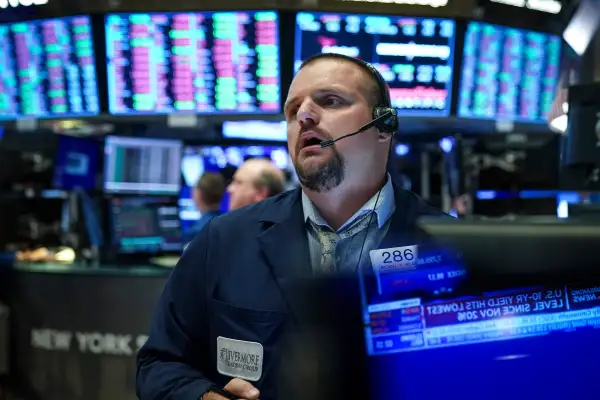The Dow Just Dropped 767 Points. Here's What You Need to Do Now
Money is not a client of any investment adviser featured on this page. The information provided on this page is for educational purposes only and is not intended as investment advice. Money does not offer advisory services.

Stocks plunged on Monday as tensions between the U.S. and China flared. While big, sudden stock-market drops are never fun, if you've been smart and disciplined with your investments, there's no reason to panic.
President Trump's trade war escalated on Monday, when China moved to devalue its currency, making Chinese goods cheaper to foreign consumers and partially countering the effects of Trump's tariffs. The stock market's reaction was swift. By mid-afternoon on Monday the Dow Jones Industrial Average was down 767 points, or about 2.9%, to close at 25,718. Other indexes, tracking European and Asian stocks, were also down.
The trade news came hours after back-to-back mass shootings in the U.S. that shocked many Americans and drew reactions from across the political spectrum. While the shootings are unlikely to have immediate economic significance, they added to many Americans' sense of foreboding.
As usual with stock market gyrations, most investors would do well to avoid reacting to Monday's big drop. Your focus should be on the long term. But it's worth putting what's happening in the market into context.
Here's what you need to know:
Why Some Investors Are Worried
President Trump won the election in 2016 in part by arguing that the U.S. needed to take a tougher stance in its trade relationship with China, the world's second-largest economy. Despite some early signs of success, efforts to renegotiate the terms of U.S.-China trade deals stalled earlier this year. As a result, Trump recently said the U.S. would levy a tax of at least 10% on nearly all of the $540 billion worth of Chinese goods imported into the U.S.
On Monday, China, which has long tightly controlled the value of its currency -- the Yuan-- responded by weakening the currency versus the U.S. dollar. That means a U.S. dollar buys slightly more Chinese goods than it did before, partially offsetting the bite of the tariffs and hopefully giving the Chinese economy, which was slowing even before the trade war began, an extra boost.
While that may benefit China in the short term, however, U.S. investors saw it as a sign that the standoff between the U.S. and China is unlikely to end any time soon -- and could ultimately end up hurting both nations' economies. What's more, like China's, the U.S. economy has also been showing signs of weakness, making pursuing a costly trade war even riskier. After all, it was only last week that bond market jitters and soft U.S. manufacturing data prompted the Federal Reserve to lower interest rates for the first time since the Great Recession.
Why You Shouldn't Overreact
While worries about the U.S. economy are real, you should never read too much into a single day's stock market moves.
For anyone who follows the stock market regularly, an 700-point drop in the Dow is eye-popping. During the height of the financial crisis, when Congress refused to back the bank bailout bill, the Dow dropped 778 points -- then the largest single-day point decline in history -- setting off a firestorm. But it's worth remembering that the Dow was only slightly above 10,000 back then, meaning the decline translated into about 7% of the stock market's total value. Today, the Dow is above 25,000 and Friday's 767-point drop translates into a percentage-point decline of less than 3%. While 7% declines are truly remarkable, 3% declines are unusual but hardly unheard of, typically taking place a few times each year.
What's more, while economists are indeed cautious about the U.S. economy, so far the signs are hardly dire. Unemployment, a key indicator of brewing trouble, remains historically low, while consumer confidence remains high. “The outlook for the U.S. economy remains favorable, and this action is designed to support that outlook,” said Fed Chair Jerome Powell in introducing the Fed's rate cut last week.
Indeed, don't forget that just last December the Dow posted its worst week in a decade, declining 1,655 points, or nearly 7% in five days. The outcome? Within a few months, investors had forgotten all about it, and the Dow reached a new record, closing above 27,000 for the first time in July.
What You Should Do
The short answer is probably nothing. While Monday's move was jarring, no one knows where the market is headed next. What we do know is that, in the long run, stocks tend to rise -- gaining about 10% a year, on average, for those who can weather the gut-wrenching volatility.
When should you do something?
If you were really sweating bullets on Monday, you should consider rethinking the balance of stocks and bonds in your portfolio. (Bonds typically rally when stocks fall, helping offset your losses.) That's not because the outlook for stocks is any worse today than it was on Friday. It's because the worst thing you can do as a stock market investor is panic and sell out when the stock market really is in the midst of a major downturn.
If you think you're prone to making that mistake, it's far better to trim your stock exposure today, with the market still relatively close to its all-time high, than later when it's not. You can get a sense of how different mixes of stocks and bonds react to different market conditions with this chart from fund company Vanguard.
